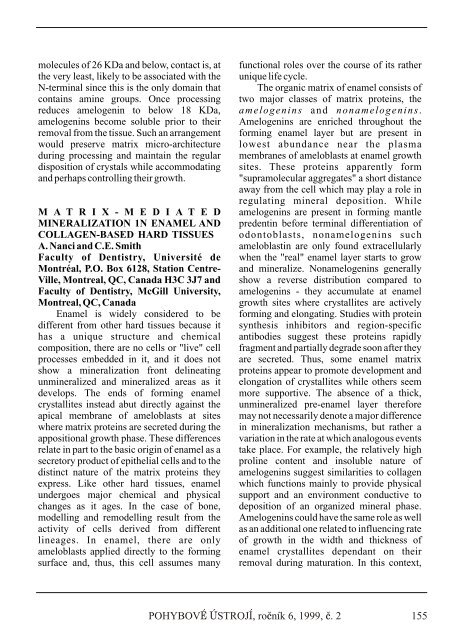POHYBOVÉ ÚSTROJÍ - Společnost pro pojivové tkáně
POHYBOVÉ ÚSTROJÍ - Společnost pro pojivové tkáně
POHYBOVÉ ÚSTROJÍ - Společnost pro pojivové tkáně
Create successful ePaper yourself
Turn your PDF publications into a flip-book with our unique Google optimized e-Paper software.
molecules of 26 KDa and below, contact is, at functional roles over the course of its rather<br />
the very least, likely to be associated with the unique life cycle.<br />
N-terminal since this is the only domain that The organic matrix of enamel consists of<br />
contains amine groups. Once <strong>pro</strong>cessing two major classes of matrix <strong>pro</strong>teins, the<br />
reduces amelogenin to below 18 KDa, amelogenins and nonamelogenins.<br />
amelogenins become soluble prior to their Amelogenins are enriched throughout the<br />
removal from the tissue. Such an arrangement forming enamel layer but are present in<br />
would preserve matrix micro-architecture lowest abundance near the plasma<br />
during <strong>pro</strong>cessing and maintain the regular membranes of ameloblasts at enamel growth<br />
disposition of crystals while accommodating sites. These <strong>pro</strong>teins apparently form<br />
and perhaps controlling their growth. "supramolecular aggregates" a short distance<br />
away from the cell which may play a role in<br />
regulating mineral deposition. While<br />
M A T R I X - M E D I A T E D amelogenins are present in forming mantle<br />
MINERALIZATION 1N ENAMEL AND predentin before terminal differentiation of<br />
COLLAGEN-BASED HARD TISSUES odontoblasts, nonamelogenins such<br />
A. Nanci and C.E. Smith ameloblastin are only found extracellularly<br />
Faculty of Dentistry, Université de when the "real" enamel layer starts to grow<br />
Montréal, P.O. Box 6128, Station Centre- and mineralize. Nonamelogenins generally<br />
Ville, Montreal, QC, Canada H3C 3J7 and show a reverse distribution compared to<br />
Faculty of Dentistry, McGill University, amelogenins - they accumulate at enamel<br />
Montreal, QC, Canada growth sites where crystallites are actively<br />
Enamel is widely considered to be forming and elongating. Studies with <strong>pro</strong>tein<br />
different from other hard tissues because it synthesis inhibitors and region-specific<br />
has a unique structure and chemical antibodies suggest these <strong>pro</strong>teins rapidly<br />
composition, there are no cells or "live" cell fragment and partially degrade soon after they<br />
<strong>pro</strong>cesses embedded in it, and it does not are secreted. Thus, some enamel matrix<br />
show a mineralization front delineating <strong>pro</strong>teins appear to <strong>pro</strong>mote development and<br />
unmineralized and mineralized areas as it elongation of crystallites while others seem<br />
develops. The ends of forming enamel more supportive. The absence of a thick,<br />
crystallites instead abut directly against the unmineralized pre-enamel layer therefore<br />
apical membrane of ameloblasts at sites may not necessarily denote a major difference<br />
where matrix <strong>pro</strong>teins are secreted during the in mineralization mechanisms, but rather a<br />
appositional growth phase. These differences variation in the rate at which analogous events<br />
relate in part to the basic origin of enamel as a take place. For example, the relatively high<br />
secretory <strong>pro</strong>duct of epithelial cells and to the <strong>pro</strong>line content and insoluble nature of<br />
distinct nature of the matrix <strong>pro</strong>teins they amelogenins suggest similarities to collagen<br />
express. Like other hard tissues, enamel which functions mainly to <strong>pro</strong>vide physical<br />
undergoes major chemical and physical support and an environment conductive to<br />
changes as it ages. In the case of bone, deposition of an organized mineral phase.<br />
modelling and remodelling result from the Amelogenins could have the same role as well<br />
activity of cells derived from different as an additional one related to influencing rate<br />
lineages. In enamel, there are only of growth in the width and thickness of<br />
ameloblasts applied directly to the forming enamel crystallites dependant on their<br />
surface and, thus, this cell assumes many removal during maturation. In this context,<br />
<strong>POHYBOVÉ</strong> <strong>ÚSTROJÍ</strong>, ročník 6, 1999, č. 2 155

















